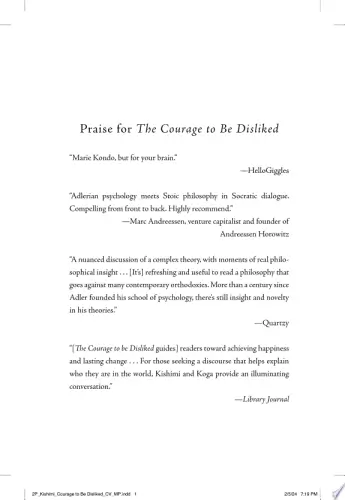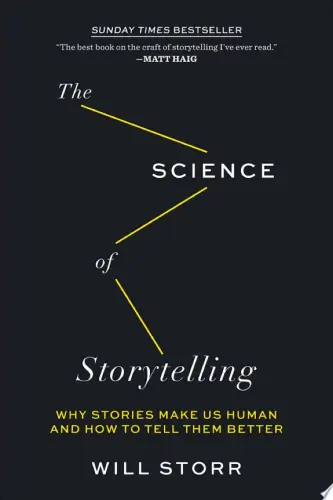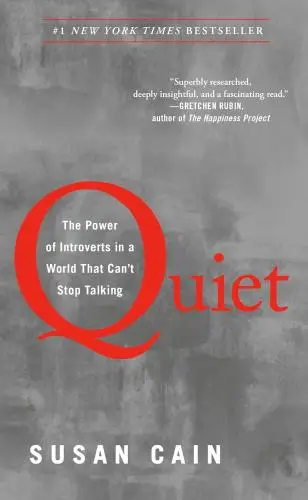Quiet
The Power of Introverts in a World That Can't Stop Talking
What's it about?
Quiet explores the power of introverts in a world that values extroversion. Through research and personal anecdotes, Cain challenges the notion that being loud and outgoing is the only path to success. She celebrates the quiet strengths of introverts, such as deep thinking and empathy, and offers strategies for introverts to thrive in a society that often overlooks their unique talents.
About the Author
Susan Cain is a bestselling author known for her book "Quiet: The Power of Introverts in a World That Can't Stop Talking." She explores the strengths and challenges of introverted individuals, advocating for a deeper understanding and appreciation of their unique qualities. Cain's writing style is insightful and thought-provoking, offering a fresh perspective on the value of introversion in a society that often favors extroverted traits. Her work encourages readers to embrace their own personalities and honor the diversity of human nature.
10 Key Ideas of Quiet
Embrace Solitude to Spark Creativity
Solitude is a crucial ingredient for creativity.
In a world that constantly bombards us with information and demands social interaction, finding time to be alone with your thoughts can lead to breakthrough ideas.
Solitude allows for deep thinking without distractions, enabling introverts to explore their inner landscape and come up with innovative solutions.
It's not about shunning social interactions but about balancing them with quiet time to recharge and reflect.
Learn DeeperSchedule Daily Quiet Time: Start by setting aside a specific time each day for solitude. It could be early in the morning before the day begins or late at night when things have calmed down. Use this time to disconnect from digital devices and engage in quiet activities that allow for reflection, such as journaling, meditating, or simply sitting in silence.
Create a Personal Space for Solitude: Designate a specific area in your home as your 'quiet space' where you can go to think and recharge without interruptions. This doesn't have to be an entire room; even a cozy corner with comfortable seating and minimal distractions can serve the purpose.
Practice Mindfulness Throughout the Day: Incorporate mindfulness practices into your daily routine to cultivate a habit of being present and aware. This can help you find moments of solitude even in the midst of a busy day. Simple practices like mindful breathing or taking a short walk alone can provide mini-breaks of solitude.
Limit Social Media and Digital Consumption: Set boundaries around your use of social media and digital devices. These platforms are designed to capture your attention and can significantly reduce the quality and quantity of your solitude. Try allocating specific times for checking these platforms and stick to them.
- Example
A writer who wakes up an hour earlier than usual to spend time alone with their thoughts and jot down ideas for their next book, finding that the quiet of the morning fosters creativity.
- Example
An artist who designates a small studio space in their apartment where they can work undisturbed, discovering that the solitude enhances their focus and allows for deeper exploration of their craft.
Prepare Thoroughly for Public Speaking to Alleviate Anxiety
Public speaking can be daunting, especially for introverts.
However, thorough preparation can significantly reduce anxiety and improve performance.
This involves researching your topic well, practicing your speech multiple times, and anticipating questions.
By preparing meticulously, you build confidence in your knowledge and ability to communicate effectively, turning a potentially stressful situation into an opportunity to showcase your expertise.
Learn DeeperStart Early: Begin preparing for your speech as soon as you know you'll be giving one. This gives you ample time to research your topic thoroughly and understand it inside out.
Practice, Practice, Practice: Rehearse your speech multiple times in front of a mirror, record yourself, or practice in front of a trusted friend or family member. This helps you get comfortable with the material and your delivery.
Anticipate Questions: Think about potential questions the audience might ask and prepare your answers. This not only helps in handling the Q&A session but also deepens your understanding of the topic.
Visualize Success: Spend a few minutes each day visualizing a successful presentation. Imagine the audience engaging positively, and yourself speaking confidently. This mental rehearsal can boost your confidence.
Seek Feedback: Before the big day, present your speech to a small group of people you trust. Ask for honest feedback on both your content and delivery, and use this input to make improvements.
- Example
Imagine you're tasked with presenting a new marketing strategy at work. You start by researching successful strategies in your industry, then draft your presentation. Over the next weeks, you rehearse it daily, tweaking the content based on feedback from colleagues. By the time you present, you're not just familiar with your material; you're an expert on it.
- Example
You're invited to speak at a local community event about the importance of sustainability. You begin by gathering the latest data and case studies. Each night, you practice parts of your speech to your family, adjusting your tone and pace based on their reactions. You also prepare answers to possible questions about how individuals can contribute to sustainability efforts. When the day comes, you're ready to inspire your audience with confidence.
Leverage Written Communication to Express Ideas Clearly
Introverts often express themselves more clearly in writing than in verbal communication.
Take advantage of this strength by using written forms of communication, such as emails, reports, or presentations, to articulate complex ideas.
Writing allows for thoughtful expression, providing the time to organize thoughts and refine arguments.
This ensures your message is conveyed precisely and effectively.
Learn DeeperStart a daily writing habit: Dedicate a specific time each day to write down your thoughts, ideas, or plans. This could be through journaling, blogging, or drafting emails you plan to send. The goal is to get comfortable with articulating your thoughts in written form.
Use written communication for important messages: Whenever you have a complex idea to share or an important message to convey, opt for an email or a report instead of a verbal conversation. This gives you the space to structure your thoughts and ensure clarity.
Prepare written summaries for meetings: If you're attending a meeting and expect to share your ideas, prepare a written summary in advance. This can help you communicate more effectively during the meeting and serve as a reference for others afterward.
Seek feedback on your written communication: Share your writings with trusted friends or colleagues and ask for their feedback. This can help you refine your writing skills and ensure your message is being received as intended.
Embrace writing tools and resources: Utilize writing tools such as grammar checkers, style guides, or writing courses to improve your written communication. These resources can help you express your ideas more clearly and effectively.
- Example
Imagine you have a groundbreaking idea for a project at work. Instead of trying to explain it verbally in a meeting where nerves might get the better of you, you decide to write a detailed proposal. In this document, you outline the concept, its benefits, and the implementation plan, allowing you to present your idea thoroughly and persuasively.
- Example
You're planning a family reunion and need to communicate the details to your extended family, some of whom you rarely speak to. You decide to write a comprehensive email that includes the date, location, what they need to bring, and other logistical details. This approach ensures everyone is on the same page and allows you to express your excitement about the event in a way that might be harder to convey over the phone.
Create a Quiet Workspace to Enhance Concentration
A quiet, personalized workspace can significantly boost productivity and focus.
Distractions are minimized, allowing for deeper concentration on tasks.
Whether it’s through noise-cancelling headphones, a secluded spot, or setting boundaries for uninterrupted work time, creating a space where you can work undisturbed is essential for introverts to thrive and produce their best work.
Learn DeeperIdentify Your Quiet Space: Start by finding a spot where you feel most at ease and least distracted. This could be a specific room in your home, a corner of a library, or even a park bench. The key is consistency; use this space regularly for work to condition your mind into 'work mode' when you're there.
Invest in Noise-Canceling Headphones: If you can't control the noise level around you, consider investing in a good pair of noise-canceling headphones. They can be a game-changer in helping you maintain focus, especially in noisy environments.
Set Clear Boundaries: Communicate with those around you about your work hours and the importance of minimizing interruptions. This might mean setting specific 'do not disturb' times or using visual cues like a closed door or a sign.
Personalize Your Workspace: Make your workspace inviting and conducive to concentration. This could involve ergonomic adjustments, adding plants, or ensuring you have all the tools you need within reach. A personalized workspace can enhance your comfort and focus.
Schedule Regular Breaks: Incorporating short breaks into your work routine can actually help maintain your concentration levels throughout the day. Use a timer to remind yourself to stand up, stretch, or take a brief walk every hour.
- Example
A writer who lives in a bustling city uses noise-canceling headphones to block out the urban soundscape, creating a silent bubble that allows them to focus on their writing without distractions.
- Example
A software developer working from home sets up a dedicated office space in a spare room. They communicate to their family that when the door is closed, they are not to be disturbed unless it's an emergency, effectively minimizing interruptions during critical work periods.
Practice Active Listening to Build Strong Relationships
Active listening is a powerful tool for building empathy and understanding in relationships.
By fully concentrating on what the other person is saying, acknowledging their feelings, and responding thoughtfully, you demonstrate respect and interest in their perspective.
This approach fosters deeper connections and trust, making it easier to collaborate and communicate effectively.
Learn DeeperGive your full attention: When someone is speaking to you, put away distractions like your phone or laptop. Make eye contact and nod to show you're engaged.
Reflect and clarify: After the person has shared their thoughts, paraphrase what they've said to ensure you've understood correctly. For example, 'So, what you're saying is...' This shows you're actively processing their words.
Ask open-ended questions: Encourage deeper conversation by asking questions that require more than a yes or no answer. For instance, 'How did that make you feel?' or 'What do you think should be done about it?'
Avoid interrupting: Let the speaker finish their thoughts without jumping in with your own opinions or solutions right away. This demonstrates respect for their perspective.
Express empathy: Acknowledge the speaker's feelings, even if you don't agree with their viewpoint. Saying something like, 'It sounds like that was really frustrating for you,' can go a long way in building understanding.
- Example
During a team meeting, when a colleague is explaining a challenge they're facing with a project, you listen intently, nodding and making eye contact. After they finish, you summarize their main points and ask how you can support them, demonstrating both understanding and willingness to help.
- Example
In a conversation with a friend who is going through a tough time, instead of offering immediate advice, you listen closely, reflect back their feelings to show you understand, and ask thoughtful questions that allow them to explore their feelings more deeply. This helps them feel heard and supported.
Deeper knowledge. Personal growth. Unlocked.
Unlock this book's key ideas and 15M+ more. Learn with quick, impactful summaries.
Read Full SummarySign up and read for free!
Quiet Summary: Common Questions
Experience Personalized Book Summaries, Today!
Discover a new way to gain knowledge, and save time.
Sign up for our 7-day trial now.
No Credit Card Needed

Similar Books

The Piano Teacher
Elfriede Jelinek
The Courage To Be Disliked
Ichiro Kishimi
We Were Liars
E. Lockhart
The Art of Solution Focused Therapy
Elliott Connie, MA, LPC
The Science of Storytelling
Will Storr
No Longer Human
太宰治
Wanting
Luke Burgis
Mrs Dalloway
Virginia Woolf
The Rational Optimist
Matt Ridley
The Social Animal
David BrooksTrending Summaries

Peak
Anders Ericsson
Never Split the Difference
Chris Voss
Smart Brevity
Jim VandeHei
The Psychology of Money
Morgan Housel
The First 90 Days
Michael D. Watkins
Atomic Habits
James Clear
Thinking, Fast and Slow
Daniel Kahneman
The Body Keeps the Score
Bessel van der Kolk M.D.
The Power of Regret
Daniel H. Pink
The Compound Effect
Darren HardyNew Books

Job Interviews For Dummies®
Joyce Lain Kennedy
Job Interviews In A Week
Alison Straw
Handbook of Career Development
Gideon Arulmani
The Art of Spending Money
Morgan Housel
$100M Offers
Alex Hormozi
A Candle for Kiri
Edna Mae Holm
Principles of Marketing, Global Edition
Gary Armstrong
Serpent Rising: The Kundalini Compendium
Neven Paar
Feeling Is the Secret
Neville Goddard

